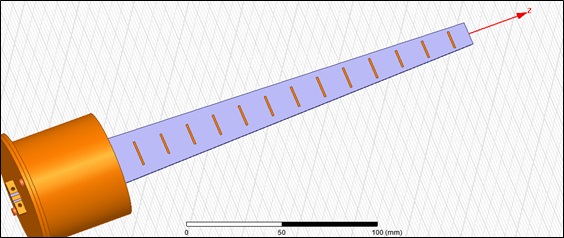Low Aperture High Gain Antenna for Wi-Fi Applications
Keywords:
Yagi Uda Antenna, Wi-Fi/WiMAX, Dielectric Antenna, Front to Back Ratio and Gain of Antenna.Abstract
This article proposes a design for a low-aperture, high-gain antenna specifically tailored for Wi-Fi applications. This project aims to enhance the performance of Wi-Fi networks by increasing signal strength and coverage area. Conventional dielectric rod antennas face three main challenges: first, they typically have low gain and excessive length; second, they exhibit high side lobe levels; and third, as the antenna length increases, side lobe levels also rise alongside gain. The proposed antenna structure effectively addresses these issues. The novelty of the proposed antenna lies in its ability to achieve greater gain at the same length compared to conventional antennas while maintaining low side lobe levels that do not increase with antenna length. The proposed design features a Yagi-Uda configuration on a printed circuit board (PCB) made from FR4 epoxy with a dielectric constant of 4.4, combined with a tapering dielectric Teflon rod with a dielectric constant of 2.1. The antenna was simulated using HFSS software, fabricated, and then tested to compare simulated and experimental results, which indicate that the proposed structure primarily operates at a frequency of 5 GHz. It achieves performance within the frequency band of 4.8–5.3 GHz, with a fractional bandwidth of 10%. At these frequencies, the structure provides a directivity of 16.4 dBi. A comparison of results demonstrates that the presented antenna outperforms traditional antennas in the same class, making it suitable for Wi-Fi, WLAN, and satellite applications. This revision enhances clarity, coherence, and overall readability while preserving the original intent and details.
References
Nursultan Meirambekuly., et al. “A High Gain Deployable L/S Band Conical Helix Antenna Integrated with Optical System for Earth Observation CubeSats” “IEEE Access” 2023, Vol.11 23097-23106.
Haoming Li; Wenhua Cao; Botao Feng; Li Deng. “A High-Gain Yagi Antenna for 5G-C Band” “4th International Conference on Electronic Information and Communication Technology (ICEICT)” 2021 IEEE.
Renato Cicchetti, Valentina Cicchetti, et al. “A Wideband High-Gain Dielectric Horn-Lens Antenna for Wireless Communications and UWB Applications” “IEEE Transactions on Antennas and Propagation” 2023, Volume: 71, Issue: 2.
Bing-Long Zheng; Guang-Hua Sun, et al. “A radiation pattern reconfigurable yagi antenna” “Sixth Asia-Pacific Conference on Antennas and Propagation (APCAP)”, 2017.
Wenzhang Zhang; Yuan Zhuang; Chaoyun Song; Yi Huang; Jiafeng Zhou, “A dual-band Quasi-Yagi wearable antenna with high directivity” “IEEE MTT-S International Wireless Symposium (IWS) 2018”.
M Shanmugapriya; J Zuvairiya Parveen; M Ushasornapriya, “Design of Polarization Reconfigurable Antenna for WiFi and WiMAX Applications” “Third International Conference on Intelligent Computing Instrumentation and Control Technologies (ICICICT)” ,2022.
Huansong Xu; Zhixi Liang; Yuanxin Li; Kuang Wang; Qi Cao; Yunliang Long, “A High-Gain Microstrip Magnetic Dipole Antenna Utilizing Slot-Loaded High-Order Mode for WLAN Applications” “IEEE Transactions on Antennas and Propagation” ( Volume: 70, Issue: 10, October 2022.
J. Jayanth, H. K. Ravikiran, M. Shivakumar, Manasa Mahadevaswamy & K. S. Gururaj, “Antenna Gain Improvement for Wi Fi Applications Using Parasitic Patch” SN computer science 2022.
Paul, LC, et al. “A compact wideband slotted hexagonal patch antenna with a modified ground structure for WiFi-5/6 communication” “emerging technology in computing, communication, and electronics (ETCCE). IEEE”, 2021.
Panpan Chen, Ru Meng, and Qi Zhu, “Design of Compact High Gain Dielectric Rod Antenna and Array in Lossy Medium,” “Microwave and Optical Technology Letters”, Vol. 55, No. 10, October 2013
M. Sporer, R. Weigel, and A. Koelpin, “A 24 GHz dual-polarized and robust dielectric rod antenna,” “IEEE Trans. Antennas Propag.”, vol. 65, no. 12, pp. 6952–6959, Dec. 2017.
T. Lonsky and P. Hazdra, “Design of a plexiglass rod antenna,”” in Proc. Conf. Microw. Techn. (COMITE)”, Apr. 2017, pp. 1–5.
Amir Mohsen Ahmadi Najafabadi et al., "Plug-in Plug-Out Multibeam Dielectric Rod Antenna for Target Dedicated mm-Wave RF-WPT Applications," “ 18th European Conference on Antennas and Propagation (EuCAP)” 17-22 March 2024
SAEED FAKHTE et al. “Enhancing the Radiation Pattern of Circularly Polarized Dielectric Rod Antenna Using Planar Excitation Method” “IEEE Access” October 2023.
J. Jayanth H. K. Ravikiran, M. Shivakumar, Manasa Mahadevaswamy, K. S. Gururaj, “Antenna Gain Improvement for Wi Fi Applications Using Parasitic Patch,” SN Computer Science 2023.
M. Sai Santhosh Kumar, Morri Bharath, Jayshree Das, B. R. Sanjeeva Reddy, “Design of a High Gain Antenna for WiFi/6E Application,” International Conference on Distributed Computing and Optimization Techniques (ICDCOT), 15-16 March 2024.

Downloads
Published
How to Cite
Issue
Section
License
Copyright (c) 2024 50sea

This work is licensed under a Creative Commons Attribution 4.0 International License.




















